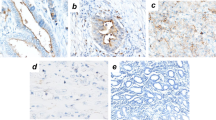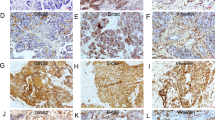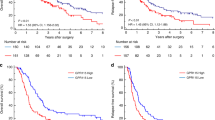Abstract
The identification of molecular markers useful for predicting prognosis in pancreatic cancer patients is crucial for advances in disease management. The epithelial cell adhesion molecule (Ep-CAM) is known to express in most epithelial malignancies and was reported as a tumor marker or a candidate of molecular targeting therapy. However, the clinical significance of Ep-CAM expression in pancreatic cancer is not well-known. We determined the difference of malignant potential between parental and Ep-CAM-transfected pancreatic cancer cell lines by using proliferation, invasion and migration assay. Furthermore, we determined the relationship between tumoral Ep-CAM expression of resected specimens and clinical prognosis in 95 pancreatic cancer patients receiving radical surgery at two different cancer centers. One of the three Ep-CAM-transfected cell lines showed significantly low proliferation rate compared with the parental cell, while there was no difference in the other two cell lines. In invasion and migration assays, Ep-CAM-transfected cells showed significantly lower malignant potential than parental in all of the three cell lines. In 95 pancreatic cancer patients, 47 patients showed high-Ep-CAM expression, while 48 patients showed low, and there was no difference of clinicopathological features between Ep-CAM high and low-expression group. High-Ep-CAM expression group showed significantly good prognosis in overall survival (3-year survival; 56.2 versus 19.2%, P=0.0018) as well as in disease-free survival (3-year survival; 40.3 versus 14.4%, P=0.038) compared with low-expression group. In addition, the impact of Ep-CAM was observed strongly in LN-negative group when the influence of Ep-CAM was examined with dividing patients into LN-positive and negative group. In multivariate analysis, Ep-CAM expression was one of the independent prognostic factors as well as histology and lymph node metastasis. Ep-CAM expression was found to be related to the suppression of pancreatic cancer cell activity and the good prognosis in pancreatic cancer patients receiving the curative resection.
This is a preview of subscription content, access via your institution
Access options
Subscribe to this journal
Receive 50 print issues and online access
$259.00 per year
only $5.18 per issue
Buy this article
- Purchase on Springer Link
- Instant access to full article PDF
Prices may be subject to local taxes which are calculated during checkout




Similar content being viewed by others
References
Armstrong A, Eck SL . (2003). EpCAM: a new therapeutic target for an old cancer antigen. Cancer Biol Ther 2: 320–326.
Balzar M, Prins FA, Bakker HA, Fleuren GJ, Warnaar SO, Litvinov SV . (1999a). The structural analysis of adhesions mediated by Ep-CAM. Exp Cell Res 246: 108–121.
Balzar M, Winter MJ, de Boer CJ, Litvinov SV . (1999b). The biology of the 17-1A antigen (Ep-CAM). J Mol Med 77: 699–712.
Basak S, Speicher D, Eck S, Wunner W, Maul G, Simmons MS et al. (1998). Colorectal carcinoma invasion inhibition by CO17-1A/GA733 antigen and its murine homologue. J Natl Cancer Inst 90: 691–697.
Burris III HA, Moore MJ, Andersen J, Green MR, Rothenberg ML, Modiano MR et al. (1997). Improvements in survival and clinical benefit with gemcitabine as first-line therapy for patients with advanced pancreas cancer: a randomized trial. J Clin Oncol 15: 2403–2413.
Calabrese G, Crescenzi C, Morizio E, Palka G, Guerra E, Alberti S . (2001). Assignment of TACSTD1 (alias TROP1, M4S1) to human chromosome 2p21 and refinement of mapping of TACSTD2 (alias TROP2, M1S1) to human chromosome 1p32 by in situ hybridization. Cytogenet Cell Genet 92: 164–165.
Cirulli V, Crisa L, Beattie GM, Mally MI, Lopez AD, Fannon A et al. (1998). KSA antigen Ep-CAM mediates cell-cell adhesion of pancreatic epithelial cells: morphoregulatory roles in pancreatic islet development. J Cell Biol 140: 1519–1534.
Edwards DP, Grzyb KT, Dressler LG, Mansel RE, Zava DT, Sledge Jr GW et al. (1986). Monoclonal antibody identification and characterization of a Mr 43 000 membrane glycoprotein associated with human breast cancer. Cancer Res 46: 1306–1317.
Evans DB, Varadhachary GR, Crane CH, Sun CC, Lee JE, Pisters PW et al. (2008). Preoperative gemcitabine-based chemoradiation for patients with resectable adenocarcinoma of the pancreatic head. J Clin Oncol 26: 3496–3502.
Fong D, Steurer M, Obrist P, Barbieri V, Margreiter R, Amberger A et al. (2008). Ep-CAM expression in pancreatic and ampullary carcinomas: frequency and prognostic relevance. J Clin Pathol 61: 31–35.
Gastl G, Spizzo G, Obrist P, Dunser M, Mikuz G . (2000). Ep-CAM overexpression in breast cancer as a predictor of survival. Lancet 356: 1981–1982.
Geer RJ, Brennan MF . (1993). Prognostic indicators for survival after resection of pancreatic adenocarcinoma. Am J Surg 165: 68–72;discussion 72-63.
Gonzalez B, Denzel S, Mack B, Conrad M, Gires O . (2009). EpCAM is involved in maintenance of the murine embryonic stem cell phenotype. Stem Cells 27: 1782–1791.
Gosens MJ, van Kempen LC, van de Velde CJ, van Krieken JH, Nagtegaal ID . (2007). Loss of membranous Ep-CAM in budding colorectal carcinoma cells. Mod Pathol 20: 221–232.
Gumbiner BM . (1996). Cell adhesion: the molecular basis of tissue architecture and morphogenesis. Cell 84: 345–357.
Infante JR, Matsubayashi H, Sato N, Tonascia J, Klein AP, Riall TA et al. (2007). Peritumoral fibroblast SPARC expression and patient outcome with resectable pancreatic adenocarcinoma. J Clin Oncol 25: 319–325.
Jojovic M, Adam E, Zangemeister-Wittke U, Schumacher U . (1998). Epithelial glycoprotein-2 expression is subject to regulatory processes in epithelial-mesenchymal transitions during metastases: an investigation of human cancers transplanted into severe combined immunodeficient mice. Histochem J 30: 723–729.
Kahlert C, Weber H, Mogler C, Bergmann F, Schirmacher P, Kenngott HG et al. (2009). Increased expression of ALCAM/CD166 in pancreatic cancer is an independent prognostic marker for poor survival and early tumour relapse. Br J Cancer 101: 457–464.
Kayahara M, Nagakawa T, Ueno K, Ohta T, Takeda T, Miyazaki I . (1993). An evaluation of radical resection for pancreatic cancer based on the mode of recurrence as determined by autopsy and diagnostic imaging. Cancer 72: 2118–2123.
Kimura H, Kato H, Faried A, Sohda M, Nakajima M, Fukai Y et al. (2007). Prognostic significance of EpCAM expression in human esophageal cancer. Int J Oncol 30: 171–179.
Li C, Heidt DG, Dalerba P, Burant CF, Zhang L, Adsay V et al. (2007). Identification of pancreatic cancer stem cells. Cancer Res 67: 1030–1037.
Li D, Xie K, Wolff R, Abbruzzese JL . (2004). Pancreatic cancer. Lancet 363: 1049–1057.
Litvinov SV, van Driel W, van Rhijn CM, Bakker HA, van Krieken H, Fleuren GJ et al. (1996). Expression of Ep-CAM in cervical squamous epithelia correlates with an increased proliferation and the disappearance of markers for terminal differentiation. Am J Pathol 148: 865–875.
Litvinov SV, Balzar M, Winter MJ, Bakker HA, Briaire-de Bruijn IH, Prins F et al. (1997). Epithelial cell adhesion molecule (Ep-CAM) modulates cell-cell interactions mediated by classic cadherins. J Cell Biol 139: 1337–1348.
Manuyakorn A, Paulus R, Farrell J, Dawson NA, Tze S, Cheung-Lau G et al. (2010). Cellular histone modification patterns predict prognosis and treatment response in resectable pancreatic adenocarcinoma: results from RTOG 9704. J Clin Oncol 28: 1358–1365.
Momburg F, Moldenhauer G, Hammerling GJ, Moller P . (1987). Immunohistochemical study of the expression of a Mr 34 000 human epithelium-specific surface glycoprotein in normal and malignant tissues. Cancer Res 47: 2883–2891.
Munz M, Kieu C, Mack B, Schmitt B, Zeidler R, Gires O . (2004). The carcinoma-associated antigen EpCAM upregulates c-myc and induces cell proliferation. Oncogene 23: 5748–5758.
Nitecki SS, Sarr MG, Colby TV, van Heerden JA . (1995). Long-term survival after resection for ductal adenocarcinoma of the pancreas. Is it really improving? Ann Surg 221: 59–66.
Noda T, Nagano H, Takemasa I, Yoshioka S, Murakami M, Wada H et al. (2009). Activation of Wnt/beta-catenin signalling pathway induces chemoresistance to interferon-alpha/5-fluorouracil combination therapy for hepatocellular carcinoma. Br J Cancer 100: 1647–1658.
Oettle H, Post S, Neuhaus P, Gellert K, Langrehr J, Ridwelski K et al. (2007). Adjuvant chemotherapy with gemcitabine vs observation in patients undergoing curative-intent resection of pancreatic cancer: a randomized controlled trial. Jama 297: 267–277.
Ogawa M, Yamamoto H, Nagano H, Miyake Y, Sugita Y, Hata T et al. (2004). Hepatic expression of ANG2 RNA in metastatic colorectal cancer. Hepatology 39: 528–539.
Osta WA, Chen Y, Mikhitarian K, Mitas M, Salem M, Hannun YA et al. (2004). EpCAM is overexpressed in breast cancer and is a potential target for breast cancer gene therapy. Cancer Res 64: 5818–5824.
Rao CG, Chianese D, Doyle GV, Miller MC, Russell T, Sanders Jr RA et al. (2005). Expression of epithelial cell adhesion molecule in carcinoma cells present in blood and primary and metastatic tumors. Int J Oncol 27: 49–57.
Ross AH, Herlyn D, Iliopoulos D, Koprowski H . (1986). Isolation and characterization of a carcinoma-associated antigen. Biochem Biophys Res Commun 135: 297–303.
Rothenberg ML, Moore MJ, Cripps MC, Andersen JS, Portenoy RK, Burris III HA et al. (1996). A phase II trial of gemcitabine in patients with 5-FU-refractory pancreas cancer. Ann Oncol 7: 347–353.
Sankpal NV, Willman MW, Fleming TP, Mayfield JD, Gillanders WE . (2009). Transcriptional repression of epithelial cell adhesion molecule contributes to p53 control of breast cancer invasion. Cancer Res 69: 753–757.
Schmidt M, Hasenclever D, Schaeffer M, Boehm D, Cotarelo C, Steiner E et al. (2008). Prognostic effect of epithelial cell adhesion molecule overexpression in untreated node-negative breast cancer. Clin Cancer Res 14: 5849–5855.
Seligson DB, Pantuck AJ, Liu X, Huang Y, Horvath S, Bui MH et al. (2004). Epithelial cell adhesion molecule (KSA) expression: pathobiology and its role as an independent predictor of survival in renal cell carcinoma. Clin Cancer Res 10: 2659–2669.
Sener SF, Fremgen A, Menck HR, Winchester DP . (1999). Pancreatic cancer: a report of treatment and survival trends for 100,313 patients diagnosed from 1985–1995, using the National Cancer Database. J Am Coll Surg 189: 1–7.
Sohn TA, Yeo CJ, Cameron JL, Koniaris L, Kaushal S, Abrams RA et al. (2000). Resected adenocarcinoma of the pancreas-616 patients: results, outcomes, and prognostic indicators. J Gastrointest Surg 4: 567–579.
Songun I, Litvinov SV, van de Velde CJ, Pals ST, Hermans J, van Krieken JH . (2005). Loss of Ep-CAM (CO17-1A) expression predicts survival in patients with gastric cancer. Br J Cancer 92: 1767–1772.
Staley CA, Lee JE, Cleary KR, Abbruzzese JL, Fenoglio CJ, Rich TA et al. (1996). Preoperative chemoradiation, pancreaticoduodenectomy, and intraoperative radiation therapy for adenocarcinoma of the pancreatic head. Am J Surg 171: 118–124; discussion 115–124.
Stoecklein NH, Siegmund A, Scheunemann P, Luebke AM, Erbersdobler A, Verde PE et al. (2006). Ep-CAM expression in squamous cell carcinoma of the esophagus: a potential therapeutic target and prognostic marker. BMC Cancer 6: 165.
Tai KY, Shiah SG, Shieh YS, Kao YR, Chi CY, Huang E et al. (2007). DNA methylation and histone modification regulate silencing of epithelial cell adhesion molecule for tumor invasion and progression. Oncogene 26: 3989–3997.
Trzpis M, McLaughlin PM, de Leij LM, Harmsen MC . (2007). Epithelial cell adhesion molecule: more than a carcinoma marker and adhesion molecule. Am J Pathol 171: 386–395.
Tsujie M, Nakamori S, Okami J, Hayashi N, Hiraoka N, Nagano H et al. (2003). Thiazolidinediones inhibit growth of gastrointestinal, biliary, and pancreatic adenocarcinoma cells through activation of the peroxisome proliferator-activated receptor gamma/retinoid X receptor alpha pathway. Exp Cell Res 289: 143–151.
Varga M, Obrist P, Schneeberger S, Muhlmann G, Felgel-Farnholz C, Fong D et al. (2004). Overexpression of epithelial cell adhesion molecule antigen in gallbladder carcinoma is an independent marker for poor survival. Clin Cancer Res 10: 3131–3136.
Winter MJ, Nagtegaal ID, van Krieken JH, Litvinov SV . (2003). The epithelial cell adhesion molecule (Ep-CAM) as a morphoregulatory molecule is a tool in surgical pathology. Am J Pathol 163: 2139–2148.
Yamashita T, Forgues M, Wang W, Kim JW, Ye Q, Jia H et al. (2008). EpCAM and alpha-fetoprotein expression defines novel prognostic subtypes of hepatocellular carcinoma. Cancer Res 68: 1451–1461.
Zhang S, Zhang HS, Cordon-Cardo C, Ragupathi G, Livingston PO . (1998). Selection of tumor antigens as targets for immune attack using immunohistochemistry: protein antigens. Clin Cancer Res 4: 2669–2676.
Author information
Authors and Affiliations
Corresponding author
Ethics declarations
Competing interests
The authors declare no conflict of interest.
Additional information
Supplementary Information accompanies the paper on the Oncogene website
Supplementary information
Rights and permissions
About this article
Cite this article
Akita, H., Nagano, H., Takeda, Y. et al. Ep-CAM is a significant prognostic factor in pancreatic cancer patients by suppressing cell activity. Oncogene 30, 3468–3476 (2011). https://doi.org/10.1038/onc.2011.59
Received:
Revised:
Accepted:
Published:
Issue Date:
DOI: https://doi.org/10.1038/onc.2011.59



